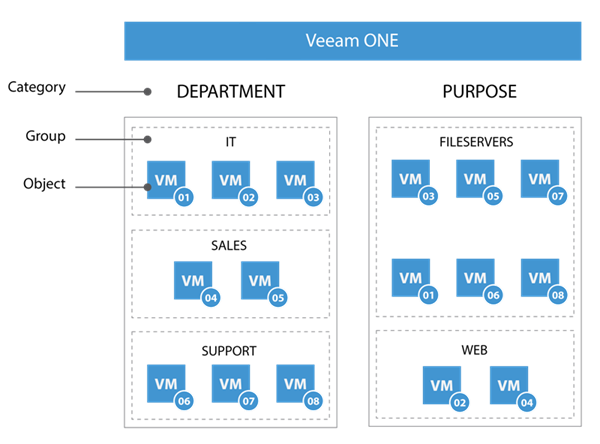 This is an archive version of the document. To get the most up-to-date information, see the current version.
This is an archive version of the document. To get the most up-to-date information, see the current version.Categorization Model and Methods
To present the virtual infrastructure, Veeam ONE Monitor uses the model that includes categories, groups and objects:
- Category is a logical division or a sector of the virtual infrastructure.
Each category includes one or more groups.
- Group is a collection of virtual infrastructure objects that share same characteristics, or match same criteria. You can think of a group as a tag assigned to an object.
Each group includes one or more VMs.
- Objects are categorized elements of the virtual infrastructure.
There are four types of objects you can categorize in Veeam ONE Monitor: clusters, hosts, storage objects and virtual machines. However, to work with failover plans in VAO, you do not need to categorize clusters, hosts or storage objects — you must group virtual machines only.
The following picture illustrates an example of Veeam ONE Monitor categorization model.

In the example above, the categorization model includes categories Department and Purpose.
- Department category includes groups IT, Sales and Support
- Purpose category includes groups Fileservers and Web
Virtual machines numbered 1-8 are included in groups within both categories.
Categorization Methods
To categorize VMs into VM groups, you can use the following methods:
- Tag-Based Categorization — the default method used by Veeam ONE Monitor to import categorization model from the vCenter Server.
If you want to create your own categories, you can disable tag-based categorization and perform categorization based on a single parameter and multiple conditions.
- Single-Parameter Categorization — the method that allows you to create groups automatically based on the values of a single property of a VM.
- Multiple-Condition Categorization — the method that allows you to create groups manually by combining multiple VM properties and logical operators.
|
As soon as you disable or enable tag-based categorization, all previously configured categories and groups will be deleted from Veeam ONE Monitor. |

